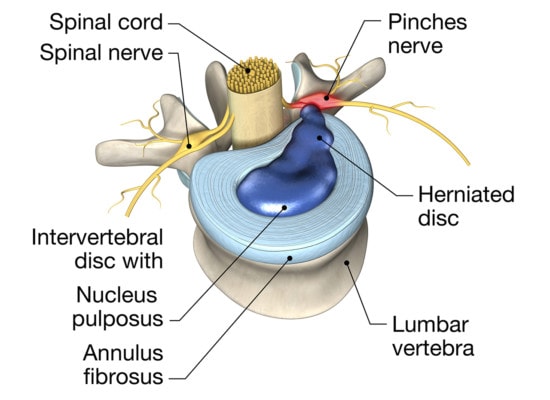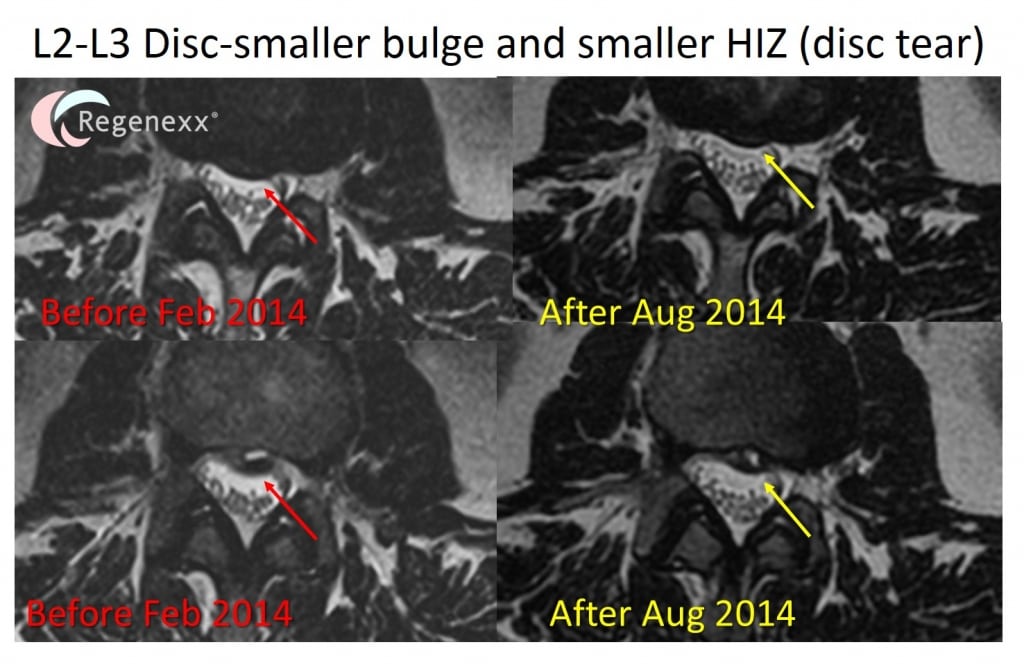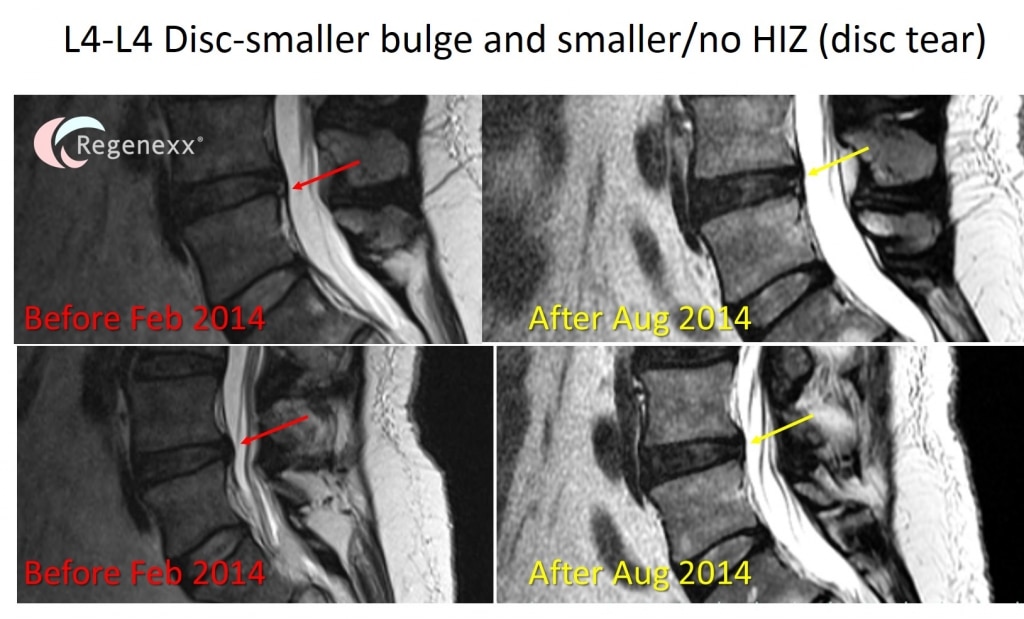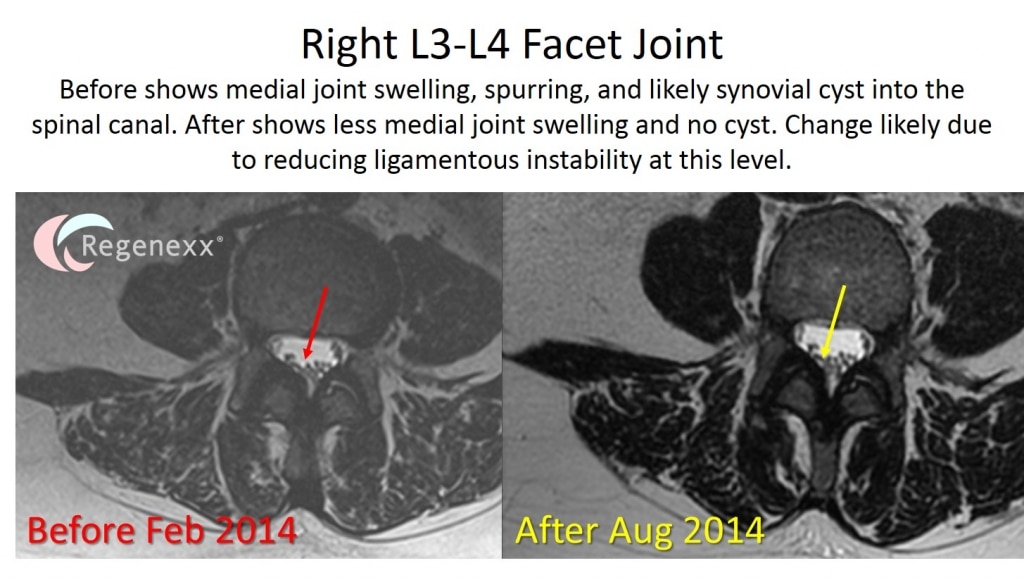Back Fusion Alternatives? Can You Avoid Surgery Without a Disc Injection?
We arguably have more experience with injecting stem cells into the discs of patients than anyone else on earth, having performed our first case in 2005. While placing stem cells in discs can be helpful in certain circumstances, can we provide back fusion alternatives without poking a hole in the disc? This is an example of a patient treated with the Regenexx-DDD procedure who now has MRI evidence that her disc is improving without ever having the disc itself injected. How’s that possible?
First, one of the most common spine surgeries today is low back fusion. Patient’s are often seeking alternatives to back fusion because the side effect profile for the surgery is horrendous. The main thrust behind a back fusion is to “stabilize” a bad disc.

Axel_Kock/Shutterstock
Physicians and patients often have a “disc fetish”. The intervertebral disc (“disc”) is a shock absorbing spacer that lives between our spine bones. It can degenerate, meaning it can be damaged and bulge or collapse, pressing on nerves. What most patients and many physicians don’t know about degenerative disc disease (DDD) is that one of it’s biggest elements is instability, where the disc itself plays only a bit part. White and Panjabi talked about this in their 1978 book, Clinical Biomechanics of the Spine, so we’ve known about this for a long time. In fact, instability does as much or more damage than a bad disc. It can fry facet joints, cause bone spurs that can press on nerves, and irritate nerves itself.
It’s because of this DDD related instability that patients are not always fixed by injecting magic stem cells into the disc. In fact, this is why we created the Regenexx-DDD procedure. The goal of this procedure is to avoid surgery by injecting an advanced third generation mix of platelet growth factors into or around all of the non-disc elements of what Panjabi called the FSU (Functional Spinal Unit). So the ligaments, joints, and nerves at the degenerated level are treated-the ligaments being lax because of the DDD, the joints being painful because of the extra wear and tear of the instability, and the nerves being aggravated for the same reason. In addition, rather than blind injections, we’ve developed advanced fluoroscopy techniques that allow the physician to target previously uninjectable, but important elements of the FSU. Many times the patient will respond beautifully without treating the disc, but sometimes the disc needs to be treated as well.
This morning’s patient is a middle aged woman who had a several year history of disabling low back pain that wasn’t improving. The traditional pain management approach of injecting anesthetics and high dose steroids into each individual structure (i.e. around her nerves or into the facet joints or into her SI joint) was providing small amounts of about 20% short-term relief with each injection. One of the things the Panjabi FSU teaches us is that in DDD, it’s much more likely that multiple structures will need attention. Hence rather than only injecting a single structure, we used the Regenexx-DDD procedure to inject her advanced platelet growth factors into her ligaments, joints, epidural, and into her SI joint. She’s had nice robust pain relief after her procedure and was able to reduce her medications for the first time since her pain began progressing. Her Internist decided to take another MRI to see if these positive symptoms changes had anything to do with changes in the structure of her spine.
The image below shows the L4-L5 disc bulge and “HIZ” (High Intensity Zone of disc tear which is the white part of the disc bulge) in the before image. In the after procedure image, the bulge is better and the HIZ is much less prominent. This was accomplished without injecting into the disc, rather improving the degenerative instability by helping the ligaments and injecting beneficial platelet growth factors at the back of the disc.
The image below is the L2-L3 disc seen from the top. Note again that the bulge is smaller and the HIZ looks better, again without injecting into the disc.

The upshot? While injecting stem cells into low back discs can be very helpful in certain circumstances, injecting anything into a disc carries more risk than not performing that procedure. Hence when you can reduce disc problems by just injecting 3rd generation, healing platelet growth factors into the ligaments, joints, and around the disc/nerve, that’s less invasive. In our book, less invasive always trumps more invasive!

NOTE: This blog post provides general information to help the reader better understand regenerative medicine, musculoskeletal health, and related subjects. All content provided in this blog, website, or any linked materials, including text, graphics, images, patient profiles, outcomes, and information, are not intended and should not be considered or used as a substitute for medical advice, diagnosis, or treatment. Please always consult with a professional and certified healthcare provider to discuss if a treatment is right for you.


